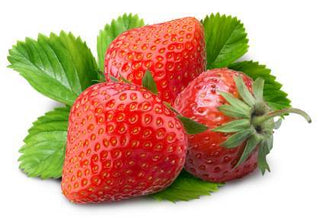(Fragaria virginiana and Fragaria chillioensis)
Strawberries are the most popular type of berry fruit in the world. Strawberries are identified by their rich, red color and heart shape. While also known for their high seed content (each berry contains on average 200 seeds), strawberries are unique in that they are the only fruit with seeds on the exterior.
With more than 600 varieties, strawberries differ in size and taste; however, their flavor can vary by weather, variety and stage of ripeness when harvested.
Strawberries have grown wild in temperate regions throughout the world for thousands of years. However, the berry was not widely appreciated in Europe until the mid-1700s. At that time, a cross between a North American cultivar noted for its flavor and a South American cultivar known for producing large sized berries produced a variety that today we know as the garden strawberry.
Nutrition Facts
A one cup serving of strawberries provides a concentrated source of carbohydrates (49 calories, 7 grams of sugars) but is a also a good source of fiber (3 grams).
Strawberries are an excellent source of vitamin C, providing 90 mg per 1 cup serving. The fruit is also an excellent source of manganese and a good source of folate and potassium (233 mg per cup).
Like many dark berries, strawberries are a rich source of phytonutrients called polyphenols. Strawberries contain two polyphenols - anthocyanins and ellagitannins. These plant compounds not only give this luscious berry its rich color but protect the plant from UV radiation. When the fruit is eaten, the antioxidant and anti-inflammatory benefits are conferred to us.
Around 200 species of pests attack strawberries. That’s why this fruit is among the twelve foods on which pesticide residues have been most frequently found. Try to find organically grown strawberries or those from a local farm where pesticides are not in use.
Selection and Storage
Strawberries are the first fruit to ripen in the spring. While they can be purchased all year around, they are best from April through July.
Strawberries age very quickly; therefore, they must be consumed several days after purchasing. Select berries that are firm, plump and a deep red in color.
Prior to storing, remove any damaged or moldy strawberries and be sure to handle them with care. To prevent spoilage, do not wash strawberries before storing or leave them out at room temperature.
Fun Facts
You may be surprised to learn that strawberries are members of the rose family.
Strawberry Festivals are held throughout the United States. Each year, while the strawberries are in season, many people join together to listen to live music, participate in many games and enjoy strawberries! To find a festival near you, go to Pick Your Own.
Recipes
Strawberries are a versatile fruit and can be enjoyed in salads, desserts, breakfast meals and smoothies. Try our Spinach & Arugula Salad with Strawberries which combines the natural sweetness of the fruit with the mildly bitter taste of arugula and spinach.

